 By DAVE KIFFER June 10, 2009
The nature of "Creek Street" was an open secret from its founding in 1903, but like most "red light" districts, a lot of information was never committed to paper. 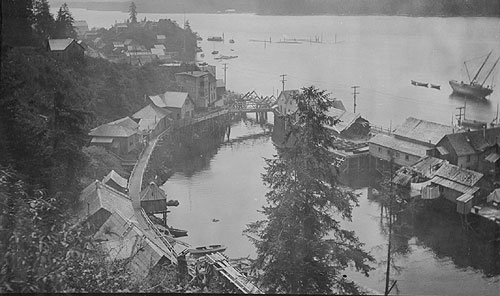 Donor: Irene McGillvray, THS 69.2.4.57 Photograph courtesy Tongass Historical Society
New Town was a mercantile area that serviced the fishing vessels and other small boats that used what was called City Float (now Casey Moran Harbor). The hillside above City Float gradually sprouted houses, in effect becoming Ketchikan's first "suburb." A boardwalk street that angled back along the original waterfront eventually became Hopkins Alley. It was along this alley that several of Ketchikan's early bawdy houses were established by the late 1890s. New Town Too Respectable By 1903, New Town had become a little too "respectable" and a group of residents in the area petitioned the city council to "move" the sporting houses elsewhere. The council met at 8 pm on March 4, 1903 in council president - Ketchikan's civic leader was not officially called 'mayor' until 1909 - George Irving's downtown office. On the agenda of the "special" meeting were several housekeeping items involving the payment of various town bills to local businesses such as Tongass Trading. But also to be discussed, according to the meeting minutes taken by town clerk, J.R. Willis, was a petition from "residents of New Town concerning the removal of certain bawdy houses." The petition itself appears not to have been saved, so it can't be determined who or how many "residents" of New Town signed the petition. Of the councilmembers who would discuss the petition, one - J.W. Young - was one of the earliest residents of New Town and prominent business owner (see "Adah Sparhawk Young, Woman Pioneer," SITNEWS May 31, 2006). Local lore has it that Dr. M.M. Hopkins, whom Hopkins Alley was named after, was behind the petition, but that can't be determined from the scant historical record. 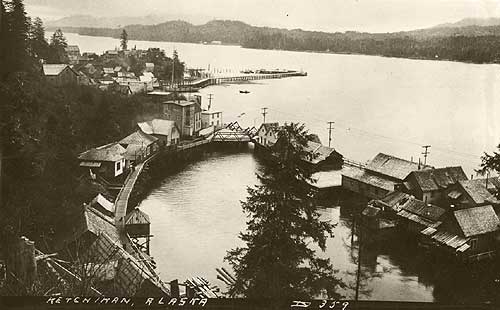 David Nicoll photo Donor: Irene McGillvray, THS 76.7.10.1 Photograph courtesy Tongass Historical Society
Not everyone was in favor of the move. A month later, on April 25, the Ketchikan Mining Journal newspaper opined on the "removal of the tenderloin district" from New Town to the "native settlement." "While the new town people are not to be blamed for taking such steps as to them that appear proper and feasible to rid themselves of an undesirable element, the propriety of seeking to impose that element upon another section of town is open to question," the Mining Journal editorialized. "Nor does the Mining Journal believe it is within the province of the council to segregate any particular section of town as a district in which social evil may be tolerated and exempted from operation of the law." The Mining Journal also went on to say that rather than create a "bawdy district" the "undesirable element" should be forced to operate outside the corporate limits of the community. Although there is no evidence from the rest of city council meeting minutes from 1903 that an "ordinance" moving the houses was ever drawn up, the houses - and several others in the community - were indeed moved to the "other side of the creek" in the summer of 1903. Some Creek Brothels Pre-dated 1903 That location was already the site of a handful of brothels anyway, although in earlier years the buildings there had also housed a shingle mill, a cooperage and several water wheels that used the power of creek to generate electricity. There were also several bawdy houses on the west side of the Creek in the neighborhood that was called Barney Way. "Indian Town" as the area south of the Creek was called, didn't start developing significantly until the Fidalgo Island Packing cannery was built south of Inman Hill in 1900. But the real boom in "Creek Street" occurred twenty years later, coinciding with two events. 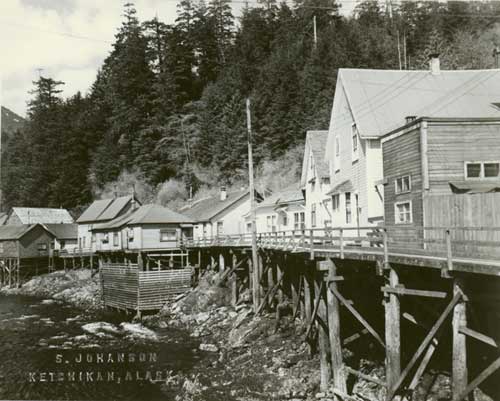 Sixten Johanson photo Donor: Inez Shewbert , THS 77.2.7.17 Photograph courtesy Tongass Historical Society
The 1920s was also the decade in which Ketchikan's canned salmon industry boomed -as did its halibut fishing fleet - and the town's population topped 5,000 making it briefly the largest community in the state. The fishing industry boom meant that hundreds of single men were in town each summer. By the middle of the decade, Ketchikan police estimated there were nearly 30 distinct brothels on Creek Street alone and a list from police records, compiled by local historian Pat Roppel, listed more than 100 individual prostitutes plying their trade then. #5 The Only 'House of Prostitution' There was a specific reason that Creek Street became a warren of numerous small houses of prostitution. Territorial law defined a "house of prostitution" as one in which three or more women were living in. If only one or two "working girls" lived in a house it was classified instead as a residence and was exempt from police inspection. The only property that was technically classified as a "house of prostitution" then was the Star Building at #5 which usually had up to half a dozen "residents" at a time, according to police records. #5 also featured a piano and a dance floor, according to Ketchikan historian June Allen. Creek Street's reputation as the place where "men and fish" both went upstream to spawn was spread far and wide. References to Ketchikan in national publications nearly always noted Creek Street's reputation as the "Barbary Coast of the North" after San Francisco's famed district of ill-repute. Alaska Congressional Delegate Dan Sutherland went as far as calling Ketchikan the most vice-ridden community in America in a speech to Congress in the mid 1920s. Ketchikan was referred to as "wicked" in Seattle, San Francisco and Los Angeles newspapers. 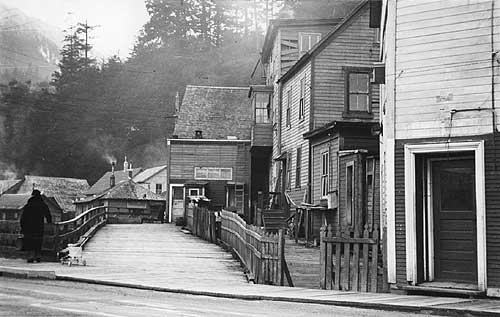 William Lattin photo Donor: William Lattin, THS 76.13.2.1 Photograph courtesy Tongass Historical Society
The fishermen who spent money on "entertainments" also bought most of their supplies in the town. And the "girls" themselves also patronized the other businesses in town, although it was well-known in the community that "respectable women" avoided the local shops on certain days of the week because those were the days that the "working girls" were allowed to shop, according to Allen. Throughout the next 30 years, activity on Creek Street proceeded apace, with a few short efforts to close things down. Sometime in the late 1920s, a group calling themselves the "Native Women and Mothers of Ketchikan" petitioned the city council. "It is a well known fact that houses of ill fame, bootlegging, dope peddaling, and gambling have been allowed to center in the section of town where our homes are located," the women wrote in an undated petition that is in the files at the Ketchikan museum. "Our young boys and girls are constantly subjected to these evil surroundings and our children have no place to play but in the midst of vice and disease. We plead with you to change conditions for us so that our young people may have a better environment and a chance to grow up to be useful American Citizens." Thirty six Native women and local Tsimpshian elder Peter Simpson signed the petition, but apparently the council took no action. Closure tried in 1946 As reported in the Ketchikan Chronicle, a group of citizens - led primarily by local religious leaders - formed to try and end Ketchikan's "wide open town" status in 1946. The ministers were William Arthur Cox of the Community Methodist Church, Major Fred Dorin of the Salvation Army, John L. Miller of the Saxman Community Church, T.M. Cole of the Seventh Day Adventist Church, Cornelius Rientjes of the Gospel Tabernacle and Rev. Roy E. Olson of the First Lutheran Church. On Sept 18, Olson addressed the Ketchikan City Council asking it to officially make prostitution illegal, rather than merely segregating its practice on Creek Street. "I wouldn't stay here five minutes if I felt I was in the minority on this issue," Olson told the council, according to the Sept. 19 edition of the Chronicle. But Mayor J.E. Johnson and council member J.E. Valentine both suggested the issue be put to a public vote instead. "It is difficult to argue this question in public," Valentine replied, adding that he felt those seeking to shut Creek Street down were in the minority. Valentine also complained that those opposed to the operations on Creek Street had originally contended the creek was a public health issue but were now saying it was a moral issue. 'Leave it to the women' Several days later, the local chapter of the American Association of University Women voted to protest the council's lack of action. By Sept. 26, a group of more than 80 people - primarily women - was meeting to discuss the situation and press the council for action, according to the Chronicle. When asked by Chronicle why the group was primarily female, Mrs. Ed Freeman, the wife of the Presbyterian minister, replied "men often make a mess of things and leave it to the women to clean them up." 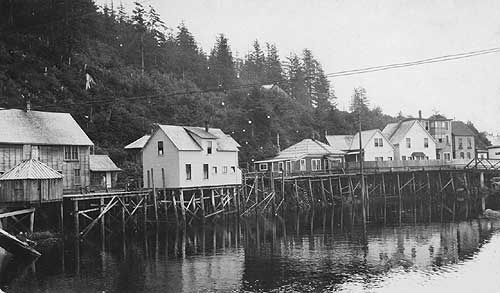 Donor: Mrs. Al Hagmoe, THS 68.10.4.82 Photograph courtesy Tongass Historical Society
The same newspaper issue also reported that venereal disease seemed to be skyrocketing in the community with more than 20 cases reported in August, as compared to only 17 cases being reported in the entire previous year. Concerns eventually culminated in a 2 1/2 hour public open house in the city council chambers to air the issue on Oct. 2. More than 400 people attended the meeting, according to the Chronicle, with a public address system being used so that people standing in the street could also hear. What they heard was Police Chief Harry Howard announce that Creek Street had been closed that afternoon. Mayor Johnson followed with a statement that the "Ketchikan Improvement Company" would begin buying property on the Creek and replacing the bawdy houses with other businesses. Most of the people who addressed the council that night spoke in favor of the city's action. But one unnamed person was quoted by the Chronicle as asking "where men were supposed to go and what they were to do with Creek Street closed. No one answered him." Houses reopened In fact, all the "men" had to do was wait. Within a few weeks, most of the houses on Creek Street were back in operation but much more quietly. And some of the the houses of ill-repute also moved into other neighborhoods like Deermount, Barney Way and Nickeyville. In December of 1952, the Chronicle reported. "One (prostitute) is reported to have purchased a residence near the ball park where she has nocturnal visitors, neighbors advised this newspaper," the Chronicle wrote on Dec. 12, 1952. "Police have been trying to keep prostitution and bootlegging on the creek to a minium under Chief Del Freimuth." Chief Freimuth would eventually be exposed as not only not keeping vice to a minimum, but within a year, he would be exposed as one of its main promoters. Olson was so frustrated by the lack of action that he resigned his ministry, as did Dr. Dwight Cramer, the city health official. National pressure on vice If local officials were not particularly interested in cracking down on vice, nationally it was a different story. The Kefauver committee was looking into organized crime nationwide and that trickled down to Ketchikan in the form of Grand Juries that began to be called to provide information on vice. Ketchikan historian June Allen - who was written extensively about Creek Street - noted in her book "Dolly's House" that the Coast Guard was also concerned about its men frequenting the street in those years and asked the American Social Hygiene Association to study venereal disease and dope addiction in the area. "The investigator went to the city manager, the chief of police and the police captain," Allen wrote. "Of course he ran into a stone wall, they did not cooperate." 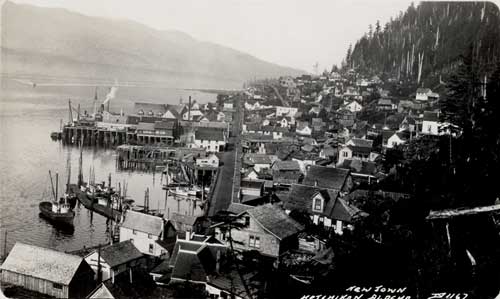 David Nicoll photo Donor: Mrs. Al Hagmoe, THS 68.10.4.115 Photograph courtesy Tongass Historical Society
Tobin main reformer Emery Tobin - the founder of the Ketchikan-based Alaska Sportsman which eventually became Alaska magazine - was one of a small group of local "reformers" who wanted to see the Creek closed. Allen wrote that he waited impatiently for the grand jury report and was angry at the results. "It said, in effect, that law enforcement was slack in enforcement of vice and after hours liquor sales, in areas of juvenile delinquency and that the jail was inadequate to meet community needs," Allen wrote. "It was a very bland report. It said nothing about 'corruption in law enforcement'." Tobin wrote several angry letters to the Ketchikan Daily News noting that police had been seen consorting with prostitutes and that city officials were ignoring the situation, but little happened. In the fall, he met the social hygiene association investigator, Malcolm Roberts. Roberts had heard of Tobin's letters and wanted his information. They both began appealing directly to George Folta, the presiding district court judge of the Federal court system in Juneau. The first Grand Jury called by Judge Folta met from Oct. 7 to Oct. 9, 1953 and - reportedly receiving little or no cooperation from local authorities - issued a report that essentially repeated the conclusions of the January panel; lax enforcement, juvenile delinquency and too small a jail. Second jury called Judge Folta immediately called a second grand jury and ordered it to focus on the issue of government corruption. Although modern grand jury deliberations are secret, the actions of the second jury were anything but. Both the Chronicle- edited by Bill Baker - and the Ketchikan Daily News - edited by Sid Charles - covered the jury sessions. Both reported on which witnesses testified and the Daily News even named the members of the jury. The Chronicle went a step further and reported what some of the witnesses allegedly said. In general, the Chronicle gave greater space to the jury hearings than the Daily News did. The Chronicle also commented on the testimony. The jury began its deliberations on Nov. 27, 1953. After interviewing more than 100 witnesses in the first two weeks, the jury made an interim recommendation that US Attorney P.J. Gilmore Jr. should be removed from office for obstruction of justice and that Captain William McKinley of the Police Department be arrested and charged with witness intimidation. Same story, different headlines The two newspapers - not surprisingly - gave different weight to the jury actions. The Chronicle issued a special "extra" edition on Dec. 12 with a banner headline running across the entire front page of the paper "Grand Jury hits Gilmore, Captain McKinley." The Daily News headlines was a single column "Jury Requests Arrests." There were also different approaches to editorials, the Chronicle weighed in with suggestions that the city fire existing police officers and hire more independent people. The Daily News opined that the grand jury "must do its duty." In general, the Daily News - despite the fact that it had printed Tobin's numerous letters on the subject, seemed lest interested in the controversy. Stories about similar police corruption charges in Juneau and Anchorage got more play than the local charges at the time. Another public hearing While the jury continued to deliberate, another public meeting was held in the city council chambers and Tobin continued to press city government to take action to resolve the situation. The Chronicle quoted him extensively and called him the "arch enemy of vice" and the "offensive generalissimo" in the battle to clean up Ketchikan. The grand jury continued its investigation and in its final report - signed by foreman T.P. Hansen and secretary George Wilson was submitted on January 4, 1954. It was a scathing indictment. The jury found that contrary to public political statements "corruption and vice in Ketchikan had not improved and instead were getting worse and more serious." The report faulted the Ketchikan Police Department for openly allowing the Creek to operate. It noted that graft was common among police officers assigned to patrol the area, primarily because police salaries were very low. "From all testimony, no other conclusion can be reached but that former Chief of Police, Delmer Freimuth, is dishonest, corrupt and abusive of his power," the final report stated. It went on to say that he had introduced officers to prostitutes, suppressed evidence during investigations and also used his official position for personal monetary gain. It also indicated that it believed he had financial arrangements with at least one "madam." 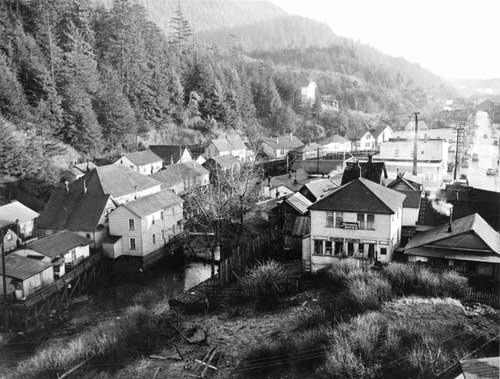 Paulu T. Saari photo Donor: Paulu T. Saari, KM 203.2.63.63 Photograph courtesy Ketchikan Museums
The report also faulted City Manager Victor Guns for being negligent of his duty and for allowing the police department to call the shots. Even worse, the manager allegedly allowed Freimuth to continue to control the police department after he had resigned in early November. Captain McKinley was allowed to investigate evidence and to continue to use the police station even after he had been arrested, the grand jury reported. The grand jury recommended that US Attorney P.J..Gilmore Jr. be removed from office because he had taken a "do nothing" attitude on the cases involving corruption and vice that had been sent to him and that Gilmore had taken an active role in dissuading both the first and second grand juries from taking any action. Before completing its report, the Grand Jury also addressed what it considered "inaccurate and misleading" statements that had been published about it in the Ketchikan Chronicle which "confused the people of Ketchikan and adversely influenced public opinion in regards to law enforcement." "Any statement by the editor of the Chronicle that we are engaged in politics is absolutely unfounded and untrue," the report concluded. City Manager Fired, DA Resigned, Police Chief Pled Guilty District Attorney Gilmore resigned to enter private practice, his assistant James Fitzgerald - who had cooperated with the grand jury - took over for him and eventually ended up on the Alaska Supreme Court. City Manager Guns was fired and later reportedly committed suicide. Chief Freimuth and Captain McKinley were charged with a variety of offenses including taking part in the operation of houses of prostitution. Eventually both pleaded guilty to conspiracy to permit prostitution and were fined $500 each and given a one year suspended jail sentence. They left town. Despite its sometimes hyperbolic coverage, even the Chronicle didn't see the story as being particularly important at the time. When it listed its top local stories of 1953, the grand jury investigations and public uproar didn't even make the list which was dominated by the construction of the new pulp mill and another disastrous commercial fishing season. And what happened to the prostitution in Ketchikan? Although many people expected the Creek to rise up again the following summer, it didn't. The fishing industry which provided the financial engine for the creek was on the wane and the community was changing dramatically as a new pulp mill was coming on line in Ward Cove. The demographics of Ketchikan was also changing as year round families were replacing the seasonal and primarily single salmon industry workers. That's not to say that some of the prostitutes who owned property didn't continue to live - or ply their trade - on the creek. But the Creek lost the brazen nature that Sutherland had called "not only rampant, but arrogant." Prostitution Left Creek, But Not Ketchikan Most of the women of the creek left the community. A few married into local families, others simply retired and lived out their days in Ketchikan, like Dolly Arthur of Dolly's House fame or Thelma Baker who lived at #5 until her death in a fire in the early 1970s. Seven years after the "closure" of the Creek, the American Social Health Association sent another "undercover" agent to Ketchikan to see whether or not prostitution had gone away with the closure of Creek Street. The investigator determined that of the old time "working girls" on the Creek only Annie Watkins at #4 and Beatrice Greene at #20 were still living on the Creek. The investigator apparently didn't contact Baker or Arthur. Watkins told the investigator that she had "had a girl last summer who worked a few days and then left" but that "nobody" was "working" on the creek in the summer of 1961. But down the Creek, Greene was apparently still open for business. "I'm afraid to open the door, it's so hot around here, it's critical," she told the investigator, according to the ASHA report which was later passed on to the Ketchikan city government. "Don't know what to say, whether to take a chance or what. I'm going out now, come back in an hour, I'll take care of you for $20." The investigator also visited several bars in Ketchikan, including the Alaska, the Pioneer, the Shamrock and the Arctic and determined that although Creek Street had closed, the "World's Oldest Profession" was still being enthusiastically practiced in Ketchikan. In fact, throughout the 1960s and 1970s, prostitution arrests were not uncommon in the First City as ladies of the line continued to find work as the timber industry attracted many single men from outlying logging camps who spent their down time in Ketchikan. To this day, prostitution has not disappeared from the First City, but it no longer as openly practiced as it was in the fifty year heyday of the "Barbary Coast of the North." 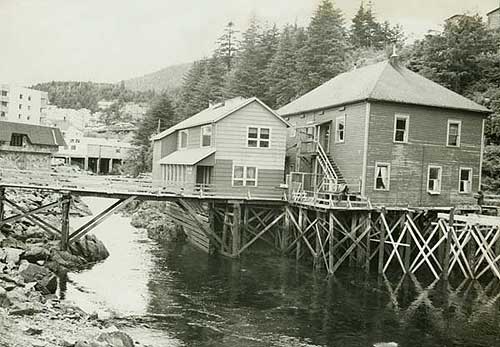 Jim Clark photo Donor: Mildred Manty Estate, THS 78.9.5.356 Photograph courtesy Tongass Historical Society Creek Street Becomes A Community Asset In the 1960s, the elements began to take a toll on Creek Street. A wind storm in 1960 destroyed three houses and seriously damaged several others. Two major fires in the 1965 and 1967 also burned several of the properties. But by 1970s, Ketchikan's tourism industry had begun to grow as larger cruise ships started coming north from Seattle and Vancouver and local entrepreneurs were the first to sense that Creek Street had potential. In 1971, four different developers unveiled plans for "revitalizing" the area. John Grainger of Creek Street Enterprises sought to buy several vacant city properties on the creek for development. Gordon Wallin of Alaska Village Development proposed a motel on the hill above the creek that would be accessed by either an elevator or an escalator. Charles Lindsley, an artist from Portland, announced plans to develop a gallery at #1. Ray Turek, a property owner in the area, also expressed interest in buying additional city property along the creek. Within a few years, an unofficial "historic district" was formed along the creek to oversee development and to maintain the historic atmosphere of the Creek. The Borough Code was amended to limit types of development in the area and to preserve the style of the existing buildings as much as possible. Zoning for much of the Creek was changed from residential to commercial. Gradually new buildings were built in the area and older properties like #5 and #28 were renovated. By the mid 1980s, several tourism related businesses had opened and Dolly Arthur's home, #24, had been turned into a small museum. "The Creek" and its colorful buildings hanging off the boardwalk above Ketchikan Creek is now an internationally recognized "symbol" of Ketchikan and one of the most photographed and visited locales in Ketchikan. It is visited by hundreds of thousands of visitors each year and the Creek continues to be one of Ketchikan's big generators of "commerce."
On the Web:
Dave Kiffer is a freelance writer living in Ketchikan, Alaska. He is also currently the Ketchikan Gateway Borough Mayor. To republish this article, the author requires a publication fee. Contact Dave at dave@sitnews.us Dave Kiffer ©2009
|